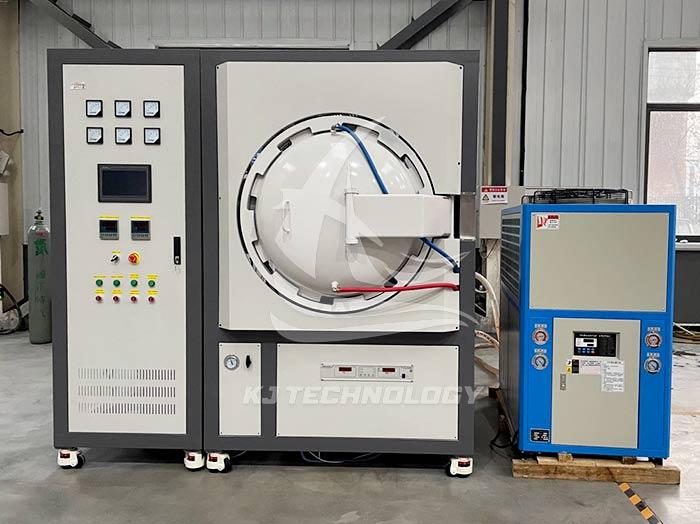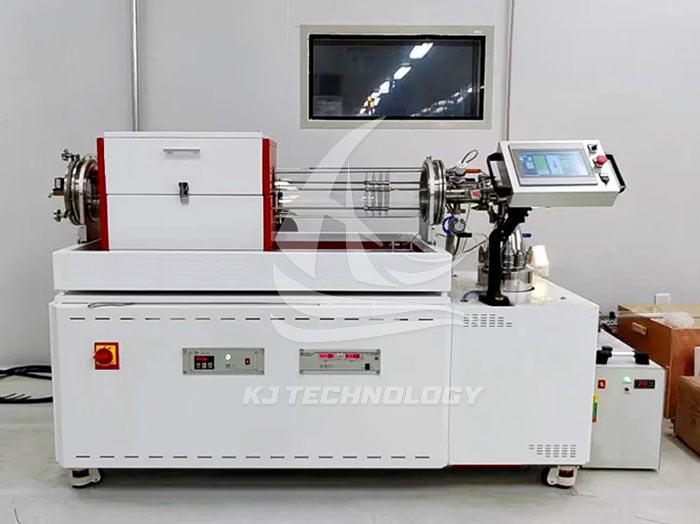High vacuum electric furnace
 11-04-2025 Author: KJ technology
11-04-2025 Author: KJ technology
High vacuum electric furnace is an advanced equipment that uses electric heating to treat materials at high temperatures in extremely high vacuum environments, and is widely used in multiple high-tech and precision manufacturing fields. The following provides a detailed introduction from four aspects: device principles, core features, application areas, and typical cases:
1. Equipment principle
A high vacuum electric furnace uses a vacuum system to reduce the pressure inside the furnace chamber to an extremely low level (usually below 10 ⁻ ³ Pa), while utilizing electric heating elements (such as resistance wires, silicon carbide rods, induction coils, etc.) to generate heat and heat the material. A vacuum environment can effectively eliminate the oxidation and pollution of materials by active gases such as oxygen and water vapor, while reducing the interference of gas molecules on thermal conduction, achieving precise temperature control and uniform heating.
2. Core Features
Ultra high vacuum environment:
By using multi-stage vacuum pump groups (such as mechanical pumps and molecular pumps), the pressure inside the furnace chamber is reduced to an extremely low level, meeting the process requirements for extremely high material purity (such as semiconductor epitaxial growth and high-purity metal purification).
High temperature processing capability:
The furnace temperature can be raised to thousands of degrees Celsius (such as 3000 ℃ for graphite furnaces), suitable for sintering, melting, and heat treatment of high-temperature alloys, ceramics, refractory metals, and other materials.
Accurate temperature control and uniformity:
Adopting intelligent temperature control systems (such as PID regulation and multi-stage program temperature control), combined with uniformly distributed heating elements, to ensure the uniformity of the temperature field inside the furnace (temperature difference is usually ≤± 5 ℃), meeting the requirements of precision manufacturing.
Multi functional process support:
Multiple process modules can be integrated, such as rapid cooling systems, multi atmosphere control (introduction of inert gases, reaction gases), pressure regulation, etc., to achieve composite processes such as sintering, annealing, quenching, CVD (chemical vapor deposition), PVD (physical vapor deposition), etc.
Automation and Security:
Equipped with an automated control system that supports remote monitoring and fault diagnosis; Equipped with safety devices such as over temperature alarm, leakage protection, and pressure safety valve to ensure safe operation.
3. Application Fields
Semiconductors and Integrated Circuits:
Crystal growth: Growing semiconductor materials such as monocrystalline silicon, silicon carbide (SiC), gallium nitride (GaN) under ultra-high vacuum to reduce impurity doping and improve crystal quality.
Epitaxial deposition: Deposition of high-purity thin films (such as silicon oxide and silicon nitride) on the surface of wafers through CVD process, used for manufacturing insulation and protective layers of integrated circuits.
Annealing treatment: Annealing the silicon wafer in a vacuum environment to eliminate lattice defects and improve electrical performance.
Aerospace and high-end equipment:
Heat treatment of high-temperature alloys: Vacuum annealing and quenching of turbine blades, combustion chambers, and other components to enhance their high temperature resistance and corrosion resistance.
Sintering of ceramic based composite materials: Sintering ceramic materials such as silicon carbide (SiC) and boron nitride (BN) under vacuum to prepare lightweight and high-strength aerospace structural components.
Coating preparation: Deposition of wear-resistant and anti-corrosion coatings (such as diamond-like carbon DLC) on metal surfaces through PVD technology to extend the service life of components.
New Energy and Environmental Protection:
Lithium battery material processing: Heat treatment of positive electrode materials (such as lithium cobalt oxide and lithium iron phosphate) under vacuum to optimize lattice structure, enhance battery capacity and cycle life.
Hydrogen storage and transportation materials: Prepare hydrogen storage alloys (such as LaNi ₅), and improve their hydrogen absorption performance through vacuum melting and heat treatment.
Environmental Protection Engineering: Utilizing vacuum incineration technology to treat waste gas and solid waste, achieving harmless treatment.
Research and experimentation:
New material research and development: Synthesize nanomaterials, superconducting materials, magnetic materials, etc. in a vacuum environment, and explore their physical and chemical properties.
Catalytic reaction research: Simulate the catalytic reaction process in extreme environments and optimize catalyst performance.
Earth and Planetary Science: Simulating the high-temperature and high-pressure internal environment of planets, studying the behavior of materials under extreme conditions.
biomedical science:
Surface modification of medical implants: vacuum coating technology (such as hydroxyapatite HA coating) is used to enhance the biocompatibility and antibacterial performance of implants.
Biosensor manufacturing: Deposition of sensitive thin films under vacuum to improve the sensitivity of sensors for detecting specific gases or biomolecules.
4. Typical case
Semiconductor industry: A certain enterprise uses a high vacuum electric furnace for the epitaxial growth of silicon carbide (SiC). By precisely controlling the pressure and temperature inside the furnace, low defect density SiC epitaxial wafers are successfully prepared for the manufacture of high-efficiency power devices.
In the field of aerospace, a certain research institute used a vacuum heat treatment furnace to anneal titanium alloy blades, significantly improving the fatigue life and high temperature resistance of the blades, meeting the stringent requirements of aviation engines.
In the field of new energy, a lithium battery enterprise uses a vacuum sintering furnace to heat treat the positive electrode material, which increases the battery capacity, prolongs the cycle life, and significantly reduces production costs.








